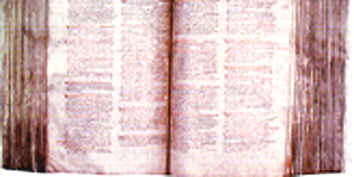The Domesday Book is one of Medieval England’s greatest treasures. The Domesday Book is closely linked with William the Conqueror’s attempt to dominate Medieval England. Along with a string of castles throughout England, the Domesday Book was to give William huge authority in England.
To further extend his grip on England, William I ordered that a book be made containing information on who owned what throughout the country. This book would also tell him who owed him what in tax and because the information was on record, nobody could dispute or argue against a tax demand. This is why the book brought doom and gloom to the people of England – hence “Domesday Book”. The decision of what someone owed was final – rather like Judgement Day when your soul was judged for Heaven or Hell.
William ordered the survey of England to take place about twenty years after the Battle of Hastings. The Saxon Chronicle states that it took place in 1085, while other sources state that it was done in 1086. The whole survey took less than a year to complete and the books can be found in the Public Records Office.
The Domesday Book forms a remarkable record of the state of England in the mid-1080’s. A sample of the questions asked is found at Ely Cathedral;
|
How many ploughs are there in the manor ? |
Norman officials checked the answers and the punishments for giving false information were severe. The reeve from a manor and six peasants were questioned for every manor visited. A reeve was a type of farm manager.
The questions were designed to find out how much each manor owed the king in tax. It also told Williamwho owned what land and how much it was worth. The book lists each manor and its owner and the value of that manor. The book has three values in it for each manor :
|
How much it was worth before the invasion of 1066 |
For Sussex in particular, the Domesday Book contains some interesting information about the area around Pevensey and Hastings – fifteen manors were attacked so badly that they were described as “waste” (as in waste land) by the men sent out to gather information for the Domesday Book. This gives a clear indication of how badly the coastal area of Sussex between Pevensey Bay and Hastings was affected by the Norman invasion. Other areas in East Sussex faired little better.
Though the Domesday Book gives historians a detailed ‘picture’ of what life was like in England in 1085-1086, the book did miss out important cities such as Winchester (then a major English city) and London. In all, 13,418 places were visited and the final record was produced in Winchester by a monk.
The survey – where it was carried out – was considered so thorough that one Englishman wrote:
| “so very thoroughly did William have the enquiry carried out, that there was not a single piece of land, not even an ox, cow or pig which escaped the notice of the survey.” |
Everybody had to pay their tax to the king. This meant that no lord or other nobleman could build up enough money to raise a private army to challenge William. It also meant that William had money to increase the size of his own army – paid for by English taxes. William did not live long enough to see the benefit of the Domesday Book. He died in September 1087 but his successor, William II (also known as William Rufus) did benefit as he knew as soon as he was crowned who owed him what and who his troublesome lords might be – because of the wealth they had.

The Domesday Book